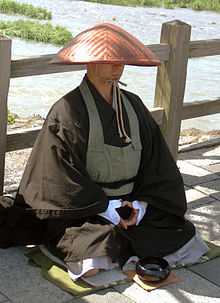Rakusu
A rakusu (絡子) is a traditionally Japanese garment worn around the neck of Zen Buddhists who have taken the precepts.[1] It can also signify Lay Ordination. It is made of 16 or more strips of cloth, sewn together into a brick-like pattern by the student during their period of preparation for their jukai or ordination ceremony.
There is no set standard, but the most common application of rakusu color is for the front of the rakusu to be black for priests and brown for teachers.[2] The back of the rakusu is left white.[2] The teacher will traditionally write the student's new Dharma name and occasionally their lineage.
History
The rakusu is a miniature version of a standard kasaya worn around the neck like a bib. The rakusu is a garment of Chinese origins[1] dating back to the periods of the Buddhist persecutions from which the Ch'an Buddhist tradition emerged as the strongest sect.
The Buddha's original outer robe was a rectangular robe in the ratio of 6 by 9. The Buddha is said to have renounced the wearing of new cloth[2] and created his robe from pieces of cast-off white burial cloth found at burial sites and dyed with saffron, for its disinfecting value. It is said in legend to resemble the rice fields seen by the Buddha himself while walking on pilgrimage.[3]
When Buddhists came to China the outer robe was modified to include a type of circular fastening clasp to assist with wearing it as the outer garment worn wrapped around the body and hanging over the left shoulder. In distinction with their Indian counterparts, the conditions of living in China led the Chinese Buddhist monks to engage in physical labor to grow their food and maintain their temples and monasteries, and on occasion to do public works like road maintenance, so the outer robe was worn only on ceremonial occasions.
Legend holds that when the Chinese emperors forbid the wearing of robes, defrocked all the Buddhist monks, and bestowed imperial favor on the Confucian and Taoist priests, then Buddhist monks created a miniature version of their robe to be worn secretly around the neck underneath their regular lay clothing.[2]
After the persecutions were over, the wearing of the rakusu was continued but now as a symbolic outer robe and only on informal occasions, such as traveling, when the ceremonial outer robe was protected by not being worn.
Ch'an Buddhism was studied by Dogen, who traveled from Japan to China in 1224. Dogen returned to Japan in 1227 or 1228 with his knowledge of Ch'an Buddhism, as well as the rakusu. The rakusu fell into general disuse in China, but due to the tradition continuing in Japan, it is now commonly associated with Zen Buddhist lineages stemming from Japan.
The rakusu today is still usually made with an ornamental circular clasp on the left side to emulate the circular clasp used on full-sized robes.
Symbolism
The rakusu represents the garments that the Buddha put together to wear after he left his palace to seek enlightenment. According to Buddhist scripture, Siddhārtha left the palace where he was a prince, and collected rags from trash heaps, funeral pyres, and various other places.[3] He then cleaned the rags by rubbing them in saffron, which gave his robes an orange-golden appearance.
In the Sōtō school, the rakusu's color is usually determined by the wearer's status.[2] For example, lay practitioners frequently receive a blue rakusu and black ones are given upon ordination as a priest. A brown rakusu indicates that the wearer has received dharma transmission and is authorized to teach.
On the back of the collar of the rakusu there is an identifying embroidered stitch that represents each of the existing schools of Zen. The Soto school uses a broken pine needle design, the Rinzai school a mountain-shaped triangle, and the Obaku school a six-pointed star.[2]
References
- ↑ 1.0 1.1 "The Buddha's Robe in Japan". About.com. Retrieved May 7, 2012.
- ↑ 2.0 2.1 2.2 2.3 2.4 2.5 "The Tradition of Buddha’s Robe". Urban Dharma. Retrieved May 7, 2012.
- ↑ 3.0 3.1 "The Buddha's Robe". About.com. Retrieved May 7, 2012.
External links
- Instructions for Sewing a Rakusu from the San Francisco Zen Center
- Rakusu Sew-a-Long from Treeleaf Zendo
- Rakusu Instructions from Upaya Institute and Zen Center
